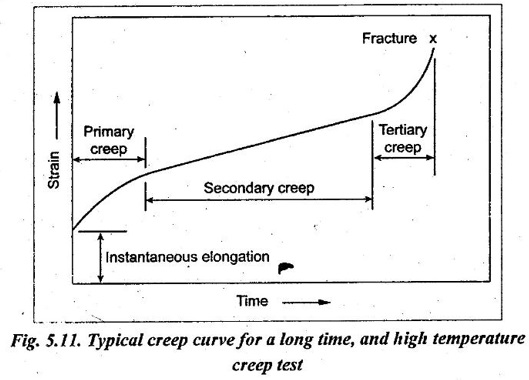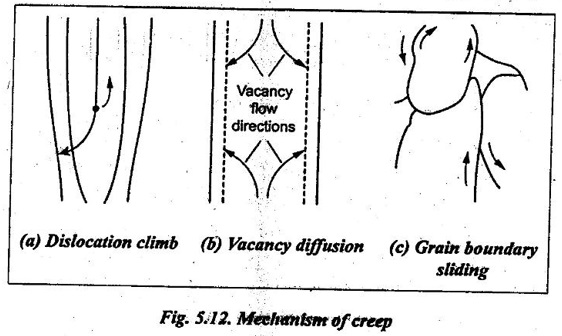Creep defined: The creep is defined as the property of a material by virtue of which it deforms continuously under a steady load.
CREEP
1. What is Meant by Creep?
✔ Creep defined: The creep is defined as the property of a material by virtue of which it deforms continuously under a steady load.
✔ In other words, creep can be defined as the permanent deformation of a material under a steady load as a function of time, usually at higher temperatures.
✔ The property of creep is important in:
(a) The soft metals used at about room temperature such as lead coverings on telephone cables and white metal bearings.
(b) The metals used at high temperature such as furnace parts, turbine blades, pressure vessel parts, rocket and missiles, supersonic jets, etc.
✔ When a material is subjected to a constant loading, then the time-dependent strain occurring under the constant stress is known as creep.
✔ Some materials such as zinc, lead and tin creep more at room temperature. Some other materials such as iron, nickel, and copper creep more at elevated temperatures only.
2. Creep Curve

A creep curve shows the variation of the extension of a meta- with time under different stresses. A typical creep curve under constant nominal stress and constant temperature, is shown in Fig.5.11.
3. Différent Stages in Creep Curve
The three distinct stages of a creep curve (Fig.5.11) are:
1. Primary creep:
✔ In this stage, the creep is mainly due to dislocation movement.
✔ The creep rate decreases with time.
✔ During this stage, the recovery effect is less than the work- hardening effect. Hence the creep rate decreases logarithmically.
2. Secondary creep:
✔ During this stage, the rates of work hardening and recovery are equal, so the material creeps at steady rate.
✔ For the above reason, secondary creep is usually termed as steady-state creep.
✔ Steady-state creep may be viscous or plastic in character, depending upon the state level and temperature.
✔ It is the important part of the creep curve which is used to estimate the service life of the alloy.
3. Tertiary creep:
✔ In this stage, creep rate increases with time until fracture occurs.
✔ Generally the tertiary creep occurs due to necking of the specimen or grain boundary sliding.
4. Important Creep Related Properties.
1. Creep strength : It is the constant nominal stress that will cause a specified creep extension in a given time at a constant temperature.
2. Creep limit: It is defined as the maximum static stress that will result in creep at a rate lower than some assigned rate at a given temperature.
3. Creep life: It is the time required for occurrence of creep fracture under a given static load.
4. Creep resistance: It is the resistance offered by the material for its continuous deformation under steady load.
5. Factors Affecting Creep
1. Grain size: Grain size influences the creep resistance. Generally, coarse-grained materials exhibit better creep resistance than fine-grained ones.
2. Thermal stability of the micro-structure : The material having greater thermal stabilities possess greater creep resistance than the material with poor thermal stability.
3. Chemical reactions: Chemical reactions in materials seriously affect the creep rate.
4. Prior strain: Prior cold working or work-hardening has also a strong effect on creep. It increases the creep resistance.
6. Mechanism of Creep Fracture
The creep fracture is due to any of the following three mechanisms:
1. Dislocation climb,
2. Vacancy diffusion, and
3. Grain boundary sliding.
1. Dislocation climb: At high temperatures, atomic movements permit the dislocation to climb. Because of this dislocation climb, the diffusion rate of vacancies may produce a motion in response to the applied stress. The mechanism of dislocation climb is illustrated in Fig.5.12 (a).

2. Vacancy diffusion: In this mechanism, the diffusion of vacancies controls the creep rate but does not involve the climb of edge dislocations. Vacancies move in response to the applied stress in the directions shown in Fig.5.12 (b). This movement finally will result in creep fracture.
3. Grain boundary sliding: At lower temperatures, the creep fracture takes place due to sliding of grain boundaries, as shown in Fig.5.12 (c).
7. Prevention of Creep Fracture
The following methods can be adopted to prevent the creep failure.
1. Use of coarse grained materials will avoid creep fracture.
2. Strain hardening can be done to avoid creep fracture.
3. The material should be free from any residual stresses and dislocations.
4. Precipitation-hardened alloys can be used to avoid creep fracture.
5. Heat treatment reduces the occurrence of creep fracture.
No comments:
Post a Comment